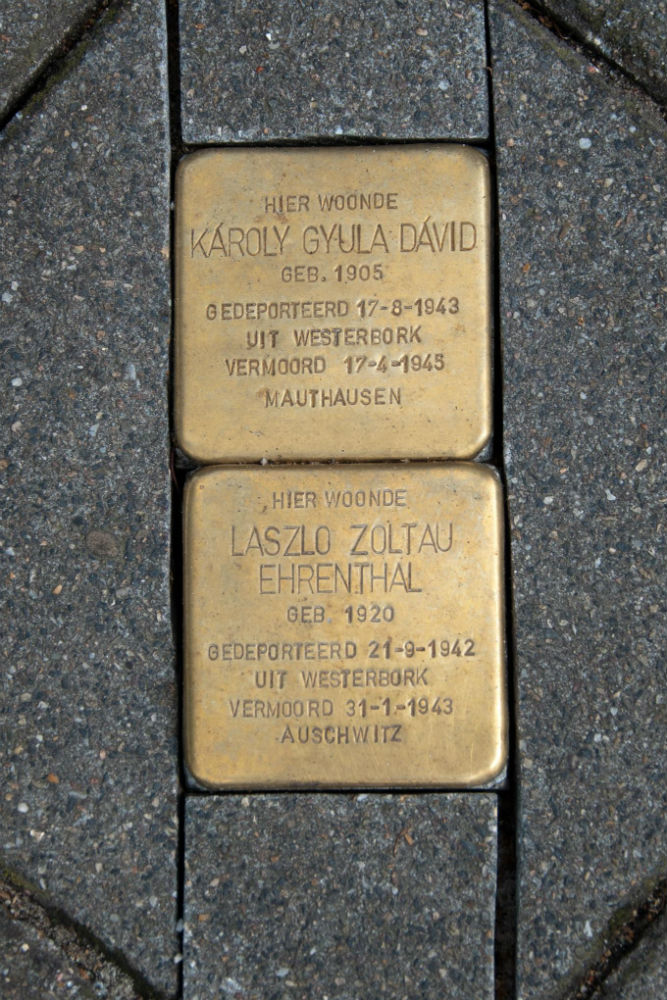Stumbling Stones Kromstraat 2
Stolpersteine / Stumbling Stones commemorate:
* Károly Gyula Dávid, born 1905, deported 17 August 1943 from Westerbork, murdered 17 April 1945 Mauthausen.
* Laszlo Zoltau Ehrenthal, born 1920, deported 21 September 1942 from Westerbork, murdered 31 January 1943 Auschwitz.
Dr. Károly Gyula Dávid was a Hungarian endocrinologist who was on the Amsterdam Organon pharmaceutical company team that discovered and characterized testosterone. He joined Organon-Oss in 1941. He was "repatriated" to Hungary along with his wife, Juliana David nee Kellerman (b. 1900), because he was Jewish. Information on his deportation to Mauthausen was not found. He was killed less than a month before Mauthausen camp was officially liberated on 5 May 1945. In the weeks before then, many prisoners from other camps plus thousands of Hungarian civilians were brought to Mauthausen. In the overcrowded conditions with shortages of food and sanitation plus 300 deaths from typhus each day, the death toll in those final weeks was high.
Dr. David’s wife and some of their children apparently survived the Holocaust, but information on how they survived was not seen.
Laszlo Zoltau Ehrenthal was apparently Dr. David’s step son: he was the son of Zoltan Ehrenthal and Julianna Ehrenthal-Kellerman. Other information on Zoltan Ehrenthal was not found, nor were dates of Julianna’s marriages. The mass deportation from Westerbork on 21 September, which included Laszlo Zoltau Ehrenthal, was a train to Auschwitz, which arrived there the next day with 713 deportees. After selection, 133 men and 50 women were admitted to the camp and the other 530 persons were murdered directly in the gas chambers. Laszlo lived only another 4 months. He was 23.
"Stolpersteine" is an art project for Europe by Gunter Demnig to commemorate victims of National Socialism (Nazism). Stolpersteine (stumbling stones) are small, 10x10cm brass plaques placed in the pavement in front of the last voluntary residence of (mostly Jewish) victims who were murdered by the Nazis. Each plaque is engraved with the victim’s name, date of birth and place (mostly a concentration camp) and date of death. By doing this, Gunter Demnig gives an individual memorial to each victim. One stone, one name, one person. He cites the Talmud: "A human being is forgotten only when his or her name is forgotten."
Borne was the first town in the Netherlands in which Stolpersteine were placed -- on 29 November 2007.
Do you have more information about this location? Inform us!
Source
- Text: Anne Palmer
- Photos: Peter Mulder
- Joods Monument
- Jewish Virtual Library: Mauthausen
- Yad Vashem Deportation Database
- Stolpersteine.eu
Nearby
Point of interest
Monument
- War Memorial Town Hall Oss - Oss
- Monument Titus Brandsma Oss - Oss
- Memorial Killed NS Employee - Oss
Cemetery
- Commonwealth War Graves Roman Catholic Cemetery Heesch - Heesch
- Dutch War Grave Roman Catholic Cemetery Heesch - Heesch
- Dutch War Grave Roman Catholic Cemetery Berghem - Berghem
Remembrance Stone
- Stumbling Stones Kortfoortstraat 195 (now opp. Kortfoortstraat 124) - Oss
- Stumbling Stones Kruisstraat 89 - Oss
- Stumbling Stone Katwijkstraat 24 - Oss




